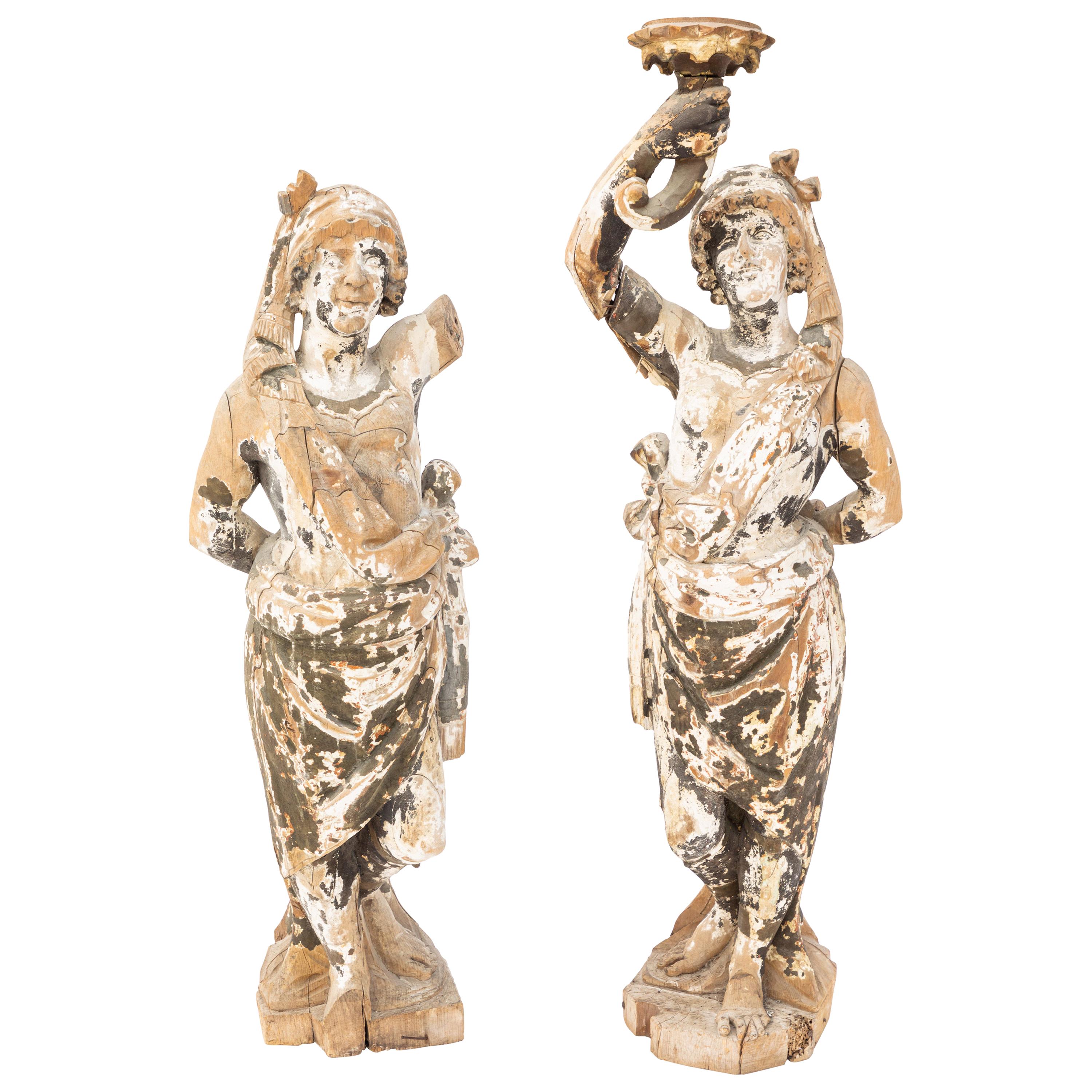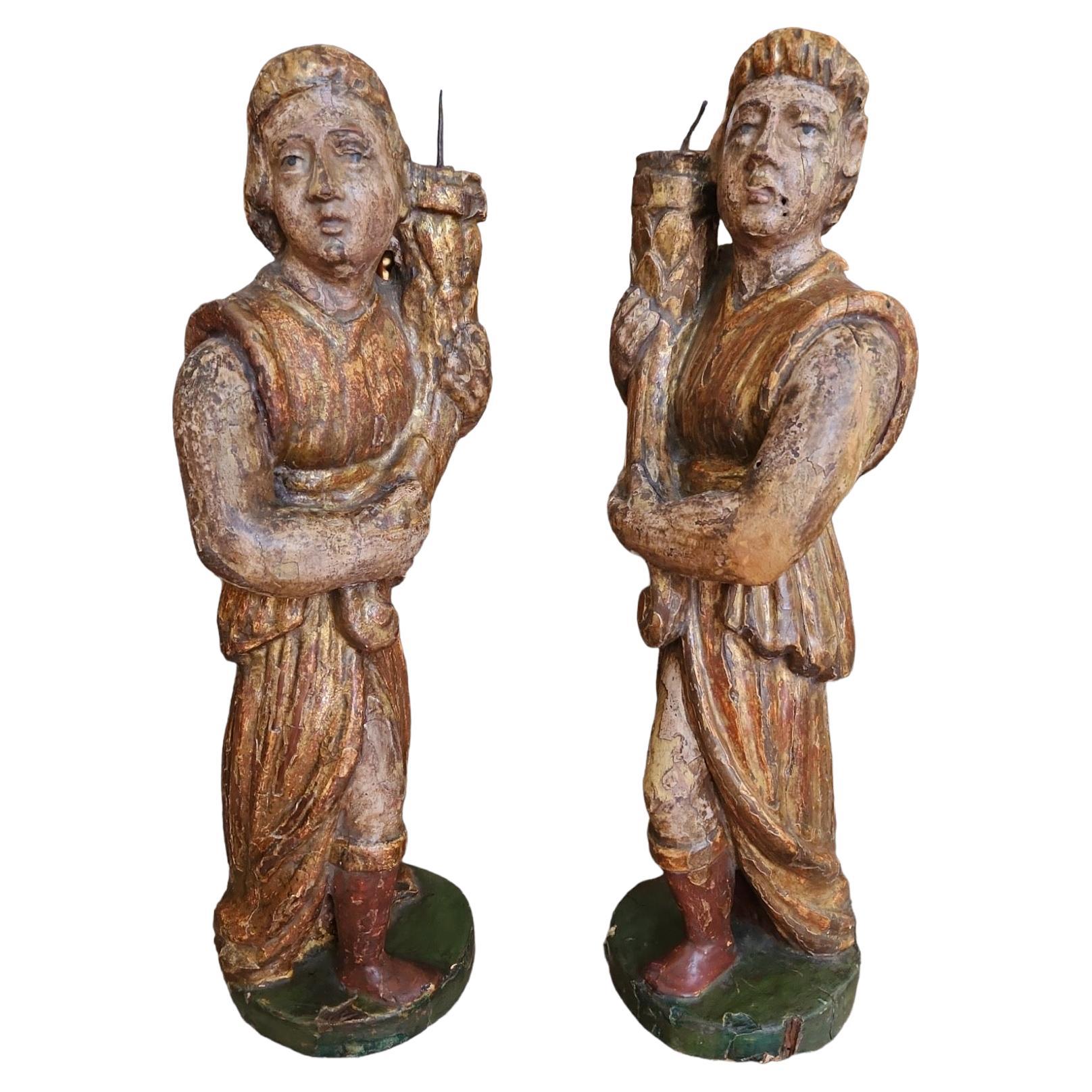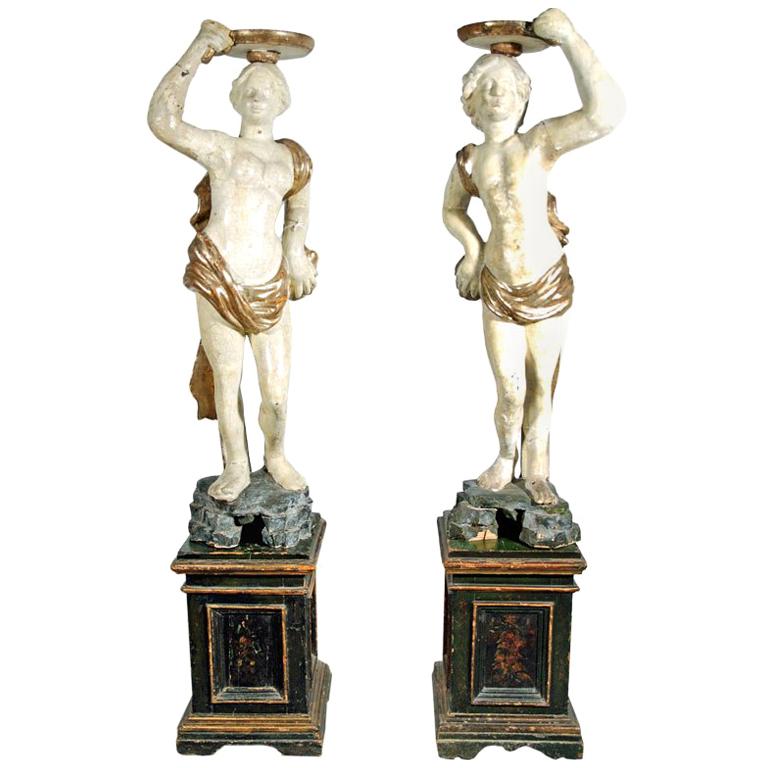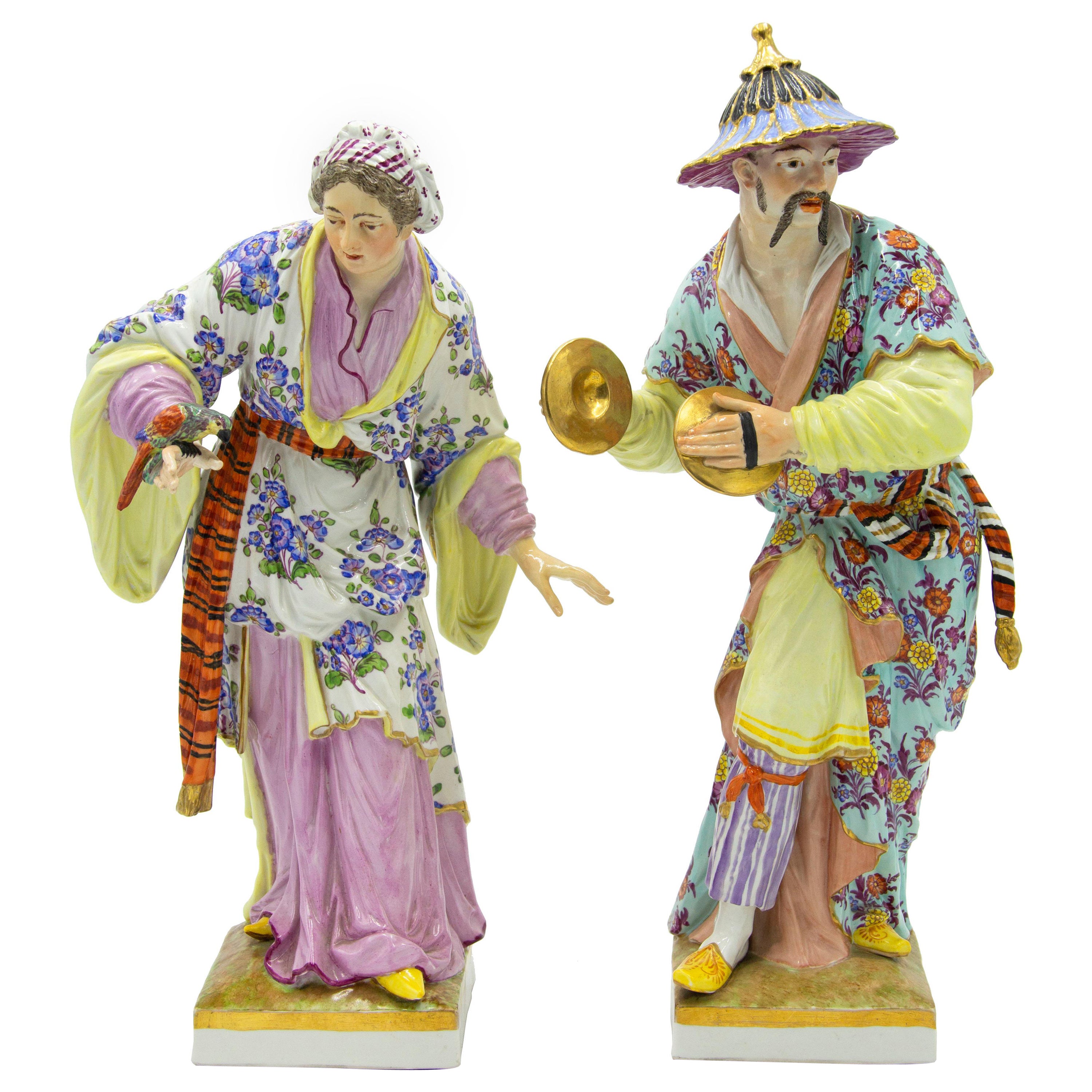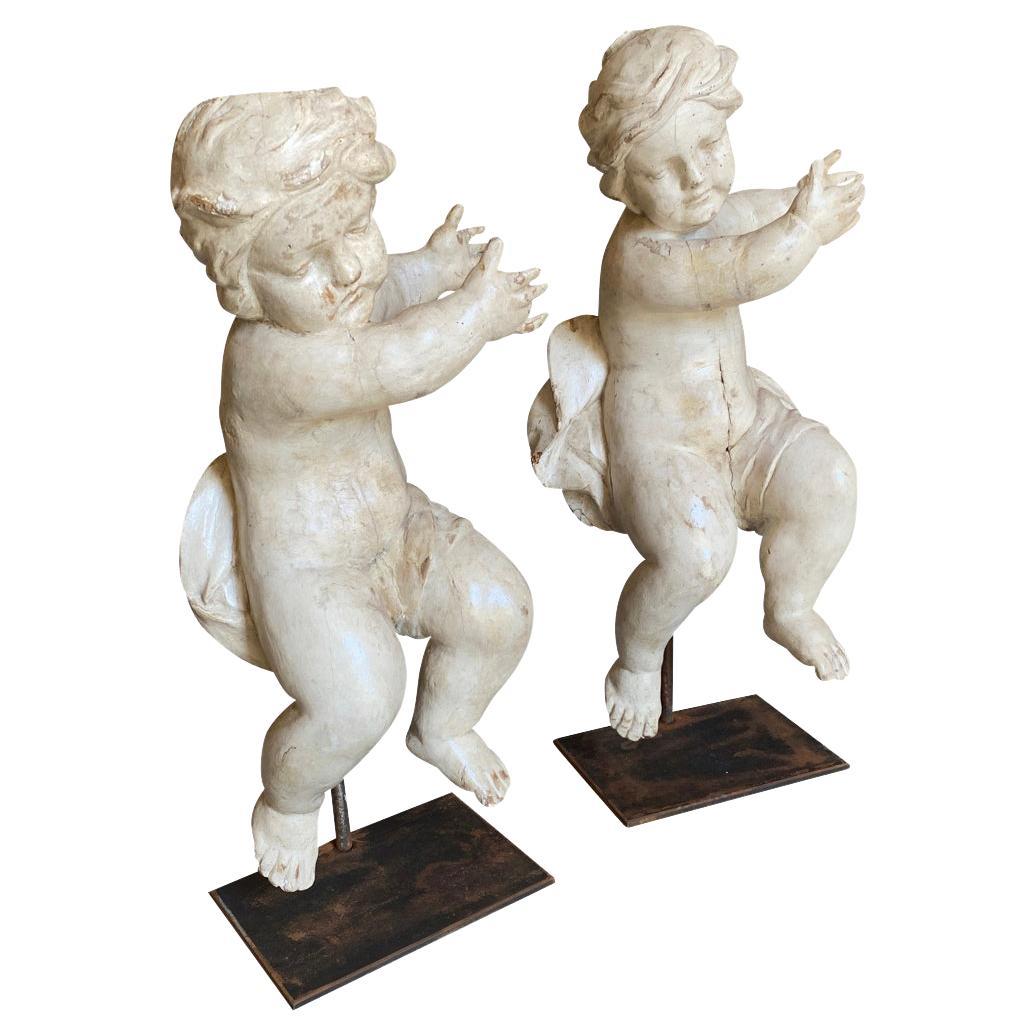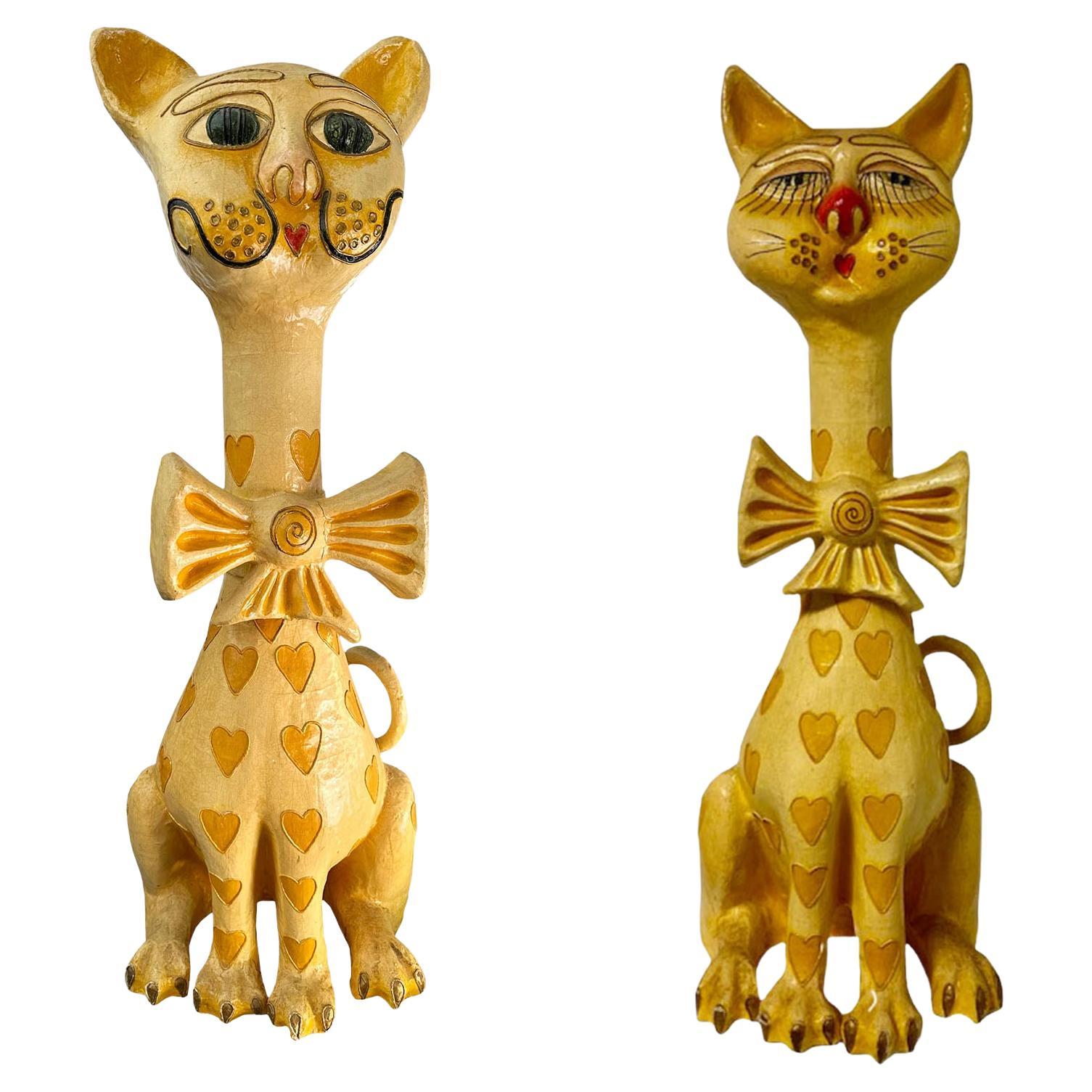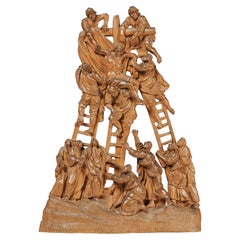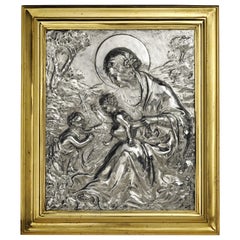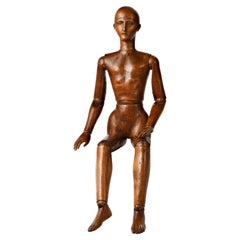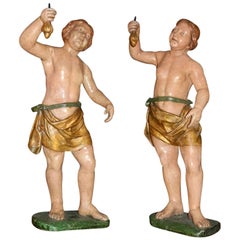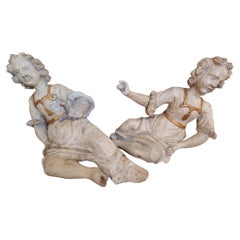
18th Century Pair of Italian Papier Mâché Chinese Figures, circa 1780
View Similar Items
Want more images or videos?
Request additional images or videos from the seller
1 of 18
18th Century Pair of Italian Papier Mâché Chinese Figures, circa 1780
About the Item
- Dimensions:Height: 25.6 in (65 cm)Width: 9.26 in (23.5 cm)Depth: 9.65 in (24.5 cm)
- Sold As:Set of 2
- Style:Chinoiserie (Of the Period)
- Materials and Techniques:Other,Other
- Place of Origin:
- Period:1780-1789
- Date of Manufacture:circa 1780
- Condition:Minor losses. Minor fading. Some repainting. Wooden bases added in later period.
- Seller Location:Milano, IT
- Reference Number:1stDibs: LU4352214038382
About the Seller
4.3
Vetted Seller
These experienced sellers undergo a comprehensive evaluation by our team of in-house experts.
Established in 1860
1stDibs seller since 2018
19 sales on 1stDibs
Typical response time: 4 hours
Associations
International Confederation of Art and Antique Dealers' Associations
More From This SellerView All
- Ancient Boxwood Micro Carving Deposition, First Half of the 18th CenturyLocated in Milano, ITBoxwood micro carving Deposition Central Europe, first half of the 18th century It measures: the sculpture 7.40 x 5.31 x 0.6 in (18.8 x 13.5 x 1.6 cm); w...Category
Antique 1740s European Baroque Figurative Sculptures
MaterialsBoxwood
- 19th Century Italian Sterling Silver Madonna, circa 1830Located in Milano, ITEmbossed and engraved silver plaque La Madonna del lago (The Madonna of the Lake) Probably Milan, post 1824 Brass frame It measures 16.14 in x 13.85 in (41 x 35.2 cm) and it weighs 10.357 pounds (4.698 g): silver 1.31 pounds (598 g) + brass 9.03 pounds (4.100 g) State of conservation: some abrasions on the bottom. The frame is old, but not original. The plaque is made up of a sheet of embossed and engraved silver, and held in a solid brass frame. It depicts the “Madonna del lago” – “Madonna of the Lake” - (the Madonna with Child and San Giovannino) by Marco d'Oggiono (Oggiono, 1474 circa - Milan, 1524 circa), while changing only the background landscape. Almost certainly the subject reproduced in the plaque was taken from a famous engraving by Giuseppe Longhi (Monza, 1766 - Milan, 1831), one of the greatest engravers of his era. The silver is unmarked, probably because originally the Madonna was due to be exposed in a church: sometimes precious metals destined for worship and liturgical use would be exempted from payment and were, therefore, not marked. It is very likely that the plaque was made in Milan because in this city in 1824 the engraving by Giuseppe Longhi was made and printed. In addition, in Milan, the alleged lost painting by Leonardo da Vinci in his Milanese period (1482-1500) would be produced; this is the painting from which Marco d'Oggiono took his version. The painting Marco d?Oggiono was one of Leonardo da Vinci's most brilliant students and collaborators (D. Sedini, Marco d’Oggiono, tradizione e rinnovamento in Lombardia tra Quattrocento e Cinquecento, Roma 1989, pp. 151-153, n. 56; p. 225, n. 124, with previous bibliography). His style reflects in every way that of the Tuscan Maestro, so much so that he was the one who executed some copies of da Vinci's paintings. The execution of the “Madonna del Lago” probably draws inspiration from a lost painting by the Maestro, created while he was living in Milan (1482-1500). There are many similarities with other works by Leonardo such as the “Vergine delle rocce” or the “Vergine con il Bambino e San Giovannino, Sant’Anna e l’Agnello”. The painting, from which the drawing and then the famous engraving were taken, is found today at the M&G Museum of Bob Jones University in Greenville, South Carolina, where it came to rest after the sale of the Harrington Collection in London in 1917. The work appears in the inventories of the collection of Napoleon and Joséphine Bonaparte at the castle of Malmaison, before 1809. The Malmaison building was born and developed in the 17th and 18th centuries. In the 18th century it belonged to Jacques-Jean Le Coulteux du Molay, a wealthy banker. Later, during the Directory, Joséphine Bonaparte de Beauharnais bought it on April 21st, 1799, but settled at the castle definitively only after her husband separated from her in 1809. She remained there until 1814, the year of her death. When Joséphine died, the estate passed to her son Eugène de Beauharnais, who moved to Munich with his whole family in 1815, bringing with him the collection of paintings he inherited from his mother. Eugène died in 1824 and his wife Augusta of Bavaria (von Bayern), unable to keep it, in 1828 sold the Malmaison to the Swedish banker Jonas-Philip Hagerman. It is likely that in this period Augusta also sold part of the paintings inherited from her husband, including the “Madonna del Lago”. This painting then came into the possession of Leicester Stanhope, fifth Earl of Harrington (1784 - 1862) and then was passed down to his descendants. In 1917, at the death of Charles, eighth Earl of Harrington, his brother Dudley inherited the title and properties and he put up a part of his collections for sale. Among these, precisely, the painting by Marco d'Oggiono was to be found. On the occasion of that auction the painting was presented as a work by Cesare da Sesto, by virtue of a handwritten note by the Countess of Harrington on the back of the table. However, already in 1857, the German critic Gustav Waagen had identified Marco d'Oggiono as the author of the painting, then exhibited in the dining room of Harrington House in London (Treasures of Art in Great Britain, in 4 volumes, London, 1854 and 1857). The engraving Giuseppe Longhi was one of the most renowned engravers in Italy between the end of the 18th century and the first quarter of the 19th century. In 1824 Giuseppe Longhi, based on a design by Paolo Caronni, made a famous engraving of the painting of Marco d?Oggiono. The activity of Longhi was then at the peak of his notoriety, enough to earn him very substantial commissions; it is not risky to suppose that some of his successful engravings were also reproduced using other means: in our case in silver. (A. Crespi, a cura di, Giuseppe Longhi 1766–1831 e Raffaello Morghen...Category
Antique 1820s Italian Neoclassical Sterling Silver
MaterialsSterling Silver, Brass
- 19th Century Italian Wood Mannequin, Circa 1870-1880Located in Milano, ITMannequin Sculpted and carved wood Italy or France, second half of the 19th century. It measures 25.59 x 6.29 x 3.54 in (65.5 x 16 x 9 cm) It weighs 2.2 lb circa (1 kg circa) St...Category
Antique 1870s Italian Other Figurative Sculptures
MaterialsWood
- Late 19th Century Italian Wood Mannequin, circa 1880Located in Milano, ITAtelier mannequin graven and carved stone pine wood Italy, late 19th century Measures: H 102 cm x 25 cm x 14 cm H 40.15 in x 9.84 in x 5.51 in Weight: circa kg 4 State of conse...Category
Antique 1880s Italian Other Figurative Sculptures
MaterialsWood
- Mid-18th Century Italian Pair of Armchairs with Leather Covers, Milan circa 1750Located in Milano, ITPair of armchairs Original impressed leather covers Milan, circa 1750 They measure: 40.94" high [18.11" to the seat] x 21.65" in deep x 27.55". 104 cm high (46 to the seat) x 55 ...Category
Antique 1750s Italian Rococo Armchairs
MaterialsLeather, Walnut
- Two Pairs of Italian Maiolica Baskets, circa 1780By Antonio FerrettiLocated in Milano, ITTwo pairs of maiolica baskets Antonio Ferretti Manufacture Lodi, circa 1770-1790 Maiolica polychrome decorated “a piccolo fuoco” (third fire). Measures: A) Height 3.54 x 6.69 x 9.84 in (9 x 17 x 25 cm); B) Height 3.93 x 7.48 x 11.02 in (10 x 19 x 28 cm). Total weight 4.85 lb (2.200 kg) State of conservation: A) One of the smaller baskets has some areas of restoration, the other slight chipping from use; B) One of the larger baskets is intact and the other shows a clearly glued break. The mold with which the baskets were forged simulates a wicker weave. The two larger works have high, vertical walls, with branch-shaped handles penetrating the weave. The painted decorations, small polychrome flowers applied only externally, highlight the points where the weaves intersect. The decision to leave the center of the basket devoid of decoration is highly unusual, but given the size and complexity of the shape, as well as the quality of the enamel, it is possible to hypothesize that it represents a precise choice in manufacturing or for a particular client. The two smaller baskets have small, twisted handles and, on the outside, reproduce more decisively the characteristic wicker weave, obtained through thin molded lines. The interior exhibits a rich, typical decoration of naturalistic flowers: a bunch centered around a main flower and secondary stems accompanied by small “semis”. The exterior of these works is also adorned with small little flowers where the weaves intersect. The size and morphological characteristics of the baskets confirm their attribution to the Lodi factory of Antonio Ferretti between 1770 and 1790, during its most successful period; by this point his original reworking of the "Strasbourg" decoration, known as "old Lodi", had achieved great fame even outside Italy. This decorative choice represented a strong point of the Lodi factory, which established itself thanks to the vivid nature of the colors made possible by the introduction of a new technique perfected by Paul Hannong in Strasbourg and which Antonio Ferretti introduced in Italy. This production process, called “piccolo fuoco” (third fire), allowed the use of a greater number of colors than in the past; in particular, the purple of Cassius, a red made from gold chloride, was introduced. Its use allowed for many more tones and shades, from pink to purple. The Ferretti family had started their maiolica manufacturing business in Lodi in 1725. The forefather Simpliciano had started the business by purchasing an ancient furnace in 1725 and, indeed, we have evidence of the full activity of the furnaces from April of the same year (Novasconi-Ferrari-Corvi, 1964, p. 26 n. 4). Simpliciano had started a production of excellence also thanks to the ownership of clay quarries in Stradella, not far from Pavia. The production was so successful that in 1726 a decree of the Turin Chamber came to prohibit the importation of foreign ceramics, especially from Lodi, to protect internal production (G. Lise, La ceramica a Lodi, Lodi 1981, p. 59). In its initial stages, the manufacture produced maolicas painted with the “a gran fuoco” (double fire) technique, often in turquoise monochrome, with ornamentation derived from compositional modules in vogue in Rouen in France. This was also thanks to the collaboration of painters like Giorgio Giacinto Rossetti, who placed his name on the best specimens next to the initials of the factory. In 1748 Simpliciano made his will (Gelmini, 1995, p. 30) appointing his son Giuseppe Antonio (known as Antonio) as universal heir. After 1750, when Simpliciano passed away, Antonio was directly involved in the maiolica factory, increasing its fortunes and achieving a reputation on a European level. Particularly important was the aforementioned introduction in 1760 of the innovative “a piccolo fuoco” (third fire) processing, which, expanding the ornamental repertoire with Saxon-inspired floral themes, could commercially compete with the German porcelains that had one of its most renowned offerings in the naturalistic Deutsche Blumen. Antonio Ferretti understood and promoted this technique and this decoration, proposing it in a fresher and more corrective version, less linked to botanical tables...Category
Antique 1770s Italian Neoclassical Ceramics
MaterialsMaiolica
You May Also Like
- Pair of Italian Painted Papier Mâché Torcheres or Candelabras, 18th CenturyLocated in Savannah, GAPair of Italian painted papier mâché figural torcheres Piedmont. Each curly haired youth with pleasant expression, clad in loose drapery holding al...Category
Antique 18th Century Italian Sculptures
MaterialsPaper
- Pair of 18th Century Italian Carved FiguresLocated in Los Angeles, CANot sure if paint is original. Finely carved and unusual. From a beautiful home in Santa Barbara.Category
Antique 18th Century Italian Neoclassical Figurative Sculptures
MaterialsWood, Paint
$7,500 / set - Pair of 18th Century Italian Carved Wood FiguresLocated in Los Angeles, CAPair of 18th century Italian carved wood figures. Originally polychromed and now aged to a shabby chic look.Category
Antique 18th Century Italian Figurative Sculptures
MaterialsWood
$3,850 / set - Pair of 18th Century Italian Polychrome Candle FiguresLocated in Los Angeles, CABeautifully carved and painted. Nice patina. From a beautiful house in Santa Barbara. They do hold candles on a spike.Category
Antique Mid-18th Century Italian Neoclassical Figurative Sculptures
MaterialsWood, Giltwood, Paint
- A Rare Pair of Neapolitan Papier Mache Figures on PlinthsLocated in Sheffield, MAEach figure is painted and gilded, and each resting on painted and polychromed plinthsCategory
Antique 18th Century and Earlier Italian Sculptures
- Pair Chinese Export Famille Rose Figures of Immortals, 18th Century, ChinaLocated in Austin, TXA near pair of Chinese export porcelain figures of the Taoist immortal Li Tieguai, Qing Dynasty, late 18th century, China. The Daoist Immortal Li Tieguai, on of the Eight Immortals...Category
Antique Late 18th Century Chinese Chinese Export Ceramics
MaterialsPorcelain
Recently Viewed
View AllMore Ways To Browse
Papier Mache Head
Indian God Sculptures
Italian Luck
Antique Earthquake
Chinoiserie Papier Mache
House Of Savoy
Papier Mache Italian
Chinese Good Luck Objects
Antique Shave
Antique Wooden Chinese Figures
21 Century Chinese Porcelain
Antique Counterweights
Chinese Papier Mache
Wooden Bobbers
Italian Chinoiserie Figures
Chinese Court Robe
Top Hat 18th Century
Oriental Hair


